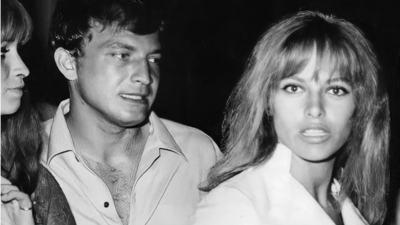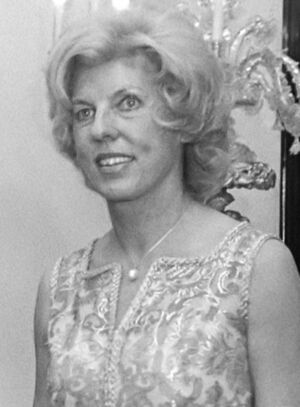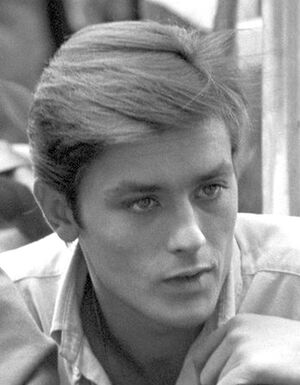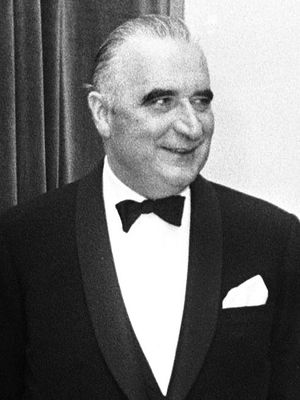Markovic affair
 Stevan Marković with Alain Delon's wife Nathalie | |
| Date | 1968 - 12 January 1976 |
| Location | France |
| Description | When a sexual blackmailer was killed in 1968, it soon turned out he had pictures of very prominent persons, including future President Georges Pompidou and his wife Claude. |
The Marković affair was a sexual blackmail operation in France in the late 1960s, involving Yugoslav petty criminals, the Corsican mafia, French President Georges Pompidou and his wife the movie star Alain Delon, and indications of deep state involvement.
The public part of the affair started when one of Delon's bodyguards, Stevan Marković, was found dead on 1 October 1968. It soon turned out a possible motive was that Marković filmed wealthy participants in compromising situations with hidden cameras at drug and sex parties he organized, and then had attempted to blackmail them.
Both the French movie star Alain Delon and his longtime friend François Marcantoni were questioned by the police for the murder, but were released.[1] Marković's murder is still unsolved.
There are indications that the blackmail operation was arranged by deep state circles around one of the mightiest businessmen in France, Ambroise Roux, before Marković became too greedy and went solo.
As part of the affair, sexually explicit photos allegedly of Claude Pompidou, were found in Marković's car after his death. A former police chief and spook Lucien Aimé-Blanc, involved in obtaining the photos, stated that they had been planted by Gaullist factions who were opposed to Pompidou.[2] George Pompidou claimed that the woman in the pictures was a prostitute who was made out to look exactly like Claude.
Contents
Stevan Marković and Miloš Milošević
Stevan Marković was born on 10 May 1937 in Belgrade, Serbia (then Yugoslavia). In the 1950s Marković and his cousin Milos Milošević (aka Milos Milos) were low-level criminals in Belgrade.
Marković left Yugoslavia in 1958, heading to Italy first and then over the Alps into France, where he settled into the immigrant community in Paris. Struggling for money, he spent seven years in poverty, taking occasional jobs as a photographer, living a transient lifestyle, sleeping in boarding houses, and occasionally being on the street. Eventually he ended up in a Belgian prison after acting as a getaway driver for a robbery gone wrong.
Milos met the movie star Alian Delon in 1962 when he was making a film in Belgrade in co-production with Yugoslavian studios. The film would never complete production, but during his stay in the country, Delon would hire Milos as a bodyguard (and possibly as a lover). They went to Venice for the filming, then to Paris, where Milos would stay until 1964 when he decided to try and find fame in Hollywood, having introduced Delon to his future wife, Nathalie Barthelemy.
With Milos leaving, Delon needed a replacement bodyguard. Milos suggested his cousin Stevan Marković. Delon helped get him out of prison, and Marković was suddenly thrust into a new world of money and connections.
Milos had a similar trajectory in Hollywood, marrying showgirl Cynthia Bouron who was notorious for affairs with several prominent Hollywood names of the era. By 1965, Milos was having an illicit liaison with actress Barbara Ann Thomason, the estranged wife of Mickey Rooney. Both Milos and Thomason were found dead at Rooney's Los Angeles home in 1966, with the official inquiry finding that Milos shot Thomason with Rooney's revolver.[3] However, rumor and context would suggest the two had been murdered. On October 20, 1973, Bouron was found dead, stuffed in the trunk of a car parked outside a grocery store in Studio City, California. She'd been tied up and beaten to death, with her killer never being found.[4]
A heavy gambler often suspected of cheating, Marković became known for his high-class parties, where he would set up covert CCTV throughout the house, especially in the bedrooms.[5] He thus collected many compromising photos of the guests that could have damaged their social status.
While he most likely did the filming on behalf of a greater network, he attempted to use pictures for blackmail, approaching several newspapers trying to sell them. Some of these photographs allegedly featured Delon and Marcantoni.[6] However, the most important photos that Marković supposedly possessed were revealing shots of George Pompidou's wife, Claude. That was a major concern to Georges Pompidou, who was preparing to run for president.[7]
On 1 October 1968, Marković's body was found in a public garbage pit in the village of Élancourt, Yvelines, west of Paris. A first autopsy indicated that the victim succumbed to blows to the head and neck by a "blunt, bulky and heavy object". On October 28, a new autopsy of Marković's body was performed, after a tip. It showed that the victim was killed by a 6.35 mm bullet fired in the back of the neck[8]. Although many people had a motive to kill him, his murder is still unsolved.
Alain Delon and François Marcantoni's involvement
In the mid-to-late 1960s, Alain Delon was one of the hottest movie stars in Europe. Yet Delon, a low-life before he became famous, was involved with the notorious Corsican gangster boss François Marcantoni.
Marcantoni was a well known Corsican mafia boss and had been a noted member of the resistance during the Second World War, receiving the War Cross and the Medal of Resistance. He had feuds with other classic names from French criminal history, such as Pierrot le Fou and Francis Vanverberghe, enjoying ingratiating himself into establishment circles and the glamorous lifestyles of people like Delon and other celebrities like Tino Rossi, Brigitte Bardot, Charles Aznavour, Jean-Paul Belmondo and Ava Gardner.
Delon had a fascination with gangsters, often seen as typecast playing them and counting real ones amongst his closest friends. Speaking with the New York Times in 1970, Delon would say that his associations were
probably something you wouldn’t understand,” adding that “It’s a question of origin. I myself am Corsican, and in places like that, they still have a sense of honor and the given word. I don’t worry about what a friend does. Each one is responsible for his own act. It doesn’t matter what he does. Most of them, the gangsters I know... were my friends before I became an actor.
Dead Marković
Delon became increasingly concerned at his bodyguard’s steadily more demanding lifestyle. Delon offered Marković a large sum in severance pay which was rejected, with the bodyguard wanting more alongside unspecified conditions that the actor couldn’t meet. Most believe that it was Delon’s unwillingness to pay that made Marković turn to blackmail.
Marković attempted to sell the photos he was taking to the national press, the bodyguard deciding to betray Delon and Marcantoni by including pictures of the pair in what he was offering. But while Delon was a megastar in France and Marcantoni was a known criminal, their importance was dwarfed by who was in other photos that Marković had in his possession — Claude Pompidou, the wife of Prime Minister Georges Pompidou. Both were said to have been regulars at Marković’s parties.
However, tensions had arisen between De Gaulle and Pompidou during the campaign. The prime minister resigned just a month later, with Pompidou being touted as the man who should De Gaulle, now 78.
On September 22, 1968, Marković was last seen on his way to a meeting with the gangster François Marcantoni. At that time he was living with compatriot Uroš Milićević in a Paris apartment owned by Delon. On October 1, 1968, a homeless man found Marković's body in a rubbish dump near Élancourt, in the greater Paris area. An initial autopsy concluded that Marković had died from a blow to the head. Marković had defended himself before his death; the body was gagged and wrapped in a plastic bag.
After a tip[9], a second autopsy on October 28, 1968 found that he had in fact been shot execution-style. The 9 mm projectile was still in the victim's head. Apparently, the shot was intended to be hidden by subsequently smashing the skull.
On October 5, the victim's brother, Alexander Marković, who lived in Belgrade, presented three letters to the Paris police, which Milićević, on Marković's instructions, had forwarded to him. One of the three letters, written in Serbo-Croatian, accused Delon and Marcantoni of an imminent act of violence:
If anything should happen to me, stick to Alain Delon, his wife and his friend François Marcantoni, a Corsican and real gangster, residing at 42 Boulevard des Batignolles
Delon was detained for 24 hours on October 12, 1968 (“garde à vue”) and interrogated for hours despite a fever. Since Delon was filming the film The Swimming Pool in St. Tropez at the suspected time of the crime, he was not charged. In addition to him, his wife Nathalie (who had to travel from London), his agent Georges Beaume, his driver Marcel Gasparini, his friend and photographer Jean-Pierre Bonotte and other acquaintances of Delon and the victim were questioned. Delon initially denied having known Marković at all. Unfortunately for him, the police already had the letters, others of which described his dire financial situation and displeasure working for Delon and his wife.[10]
In one letter, he hinted that he intended to “do something big” to turn his life around. The letters also identified Marcantoni, and police investigations quickly uncovered the sex parties and those involved, including Delon and the Pompidous, plus the allegations that Marković had photos of Claude Pompidou.
The examining magistrate René Patard initially brought charges against Marcantoni, who in May 1968 had purchased a mattress packed in a plastic bag of the kind used to dispose of the body of Marković, which led to Marcantoni being held in custody, but later released.
In 1975 the file on the Marković case was closed without result. The witness Uroš Milićević, who was the last to see Marković, was found shot dead in a hotel in Brussels in 1976.
Rumors swirled that Delon had been involved in the killing as Marković had him on camera having gay sex, which many believed would hurt his status as a sex symbol and major European movie star. However, when questioned by the BBC over the matter in 1969, Delon was happy to hint that he was bisexual without directly saying so, seeming to contradict the belief that he’d want to cover up his sexuality. However, exactly what blackmailable acts were on film, is still unknown. Delon's commanding officer during the war in Indochina described hims as "a sadist, a boy who enjoyed killing, a sexual deviant.”
Akov's allegations
At the end of October, examining magistrate René Patard received a letter addressed to Alain Delon by a Yugoslav convict held in the Fresnes prison, telling how he sympathizes with Delon's situation. The author was Boriboj Akov (Akow). Aged 25, he is imprisoned for theft, concealment and possession of weapons. His letter, dated October 10, was intercepted by the prison services. On October 30, Inspector Georges Manceau went to Fresnes to question Akov. He gives a testimony which fits in with the rumors that has upset all of high-society Paris. Marković would photograph his conquests in lascivious poses, in order to blackmail them. The two Yugoslavs had participated in "fine parties" in the company of upper class women. Akov goes further: he said he had accompanied Marković to an “orgy” organized in a villa in Montfort-l'Amaury, in which “the Prime Minister's wife” also took part.
These allegations are so huge that the police officer asks Akov to be careful and asks him to provide proof of what he is saying. Akov then changes his mind and is content with innocuous statements on the record. Manceau reports on the interview to Commissioner Samson, and then takes a few days off. On his return, he finds that his office has been broken into and that the notes he took during the interview – apart from the minutes – have disappeared. Commissioner Samson explains to him that it was he who stole them in order to send them urgently to the Minister of the Interior, Raymond Marcellin.[11]
On November 5, examining magistrate Patard himself interrogates Akov in Fresnes prison. He maintains having participated in an orgy an evening during the summer of 1966, in a villa of Montfort-l'Amaury. However, he declares that he saw nothing abnormal and denies having mentioned “the Prime Minister's wife". This interrogation record nullifies Akov's previous statements. The villa of Montfort-l'Amaury where the evening took place is identified as belonging to the industrialist Ambroise Roux.[12].
Involvement of the Pompidous

The Pompidou couple, especially Claude Pompidou, belonged (at least until Pompidou took office as Prime Minister in 1962) to the jet set of Paris and St. Tropez. They associated with intellectuals and artists.
The death of Stevan Marković provoked many rumours, many suggesting the existence of group sex photos with Madame Pompidou. Pompidou was then running his campaign for presidency and wanted to dispel them as soon as possible. He formally told the public that all the talk concerning the Marković affair were rumours.[5] Pompidou was convinced that a group of Gaullists were responsible for the character assassination campaign against him and his wife[13], and accused Louis Wallon and Henri Capitant of using the French espionage service SDECE to frame him.
The rumours still hurt his campaign.[2][14] He admitted that he and his wife had been at parties with Marković and Delon. But remarkably, he claimed the woman in the photos was a prostitute who simply greatly resembled his wife. A former police chief, Lucien Aimé-Blanc, who had long been involved with the SDECE, later claimed in his memoirs that an anonymous friend asked him to produce a prostitute who was blonde and in her forties, who was then used as Madame Pompidou's lookalike and photographed her in compromising positions with another woman.
After he nevertheless won the 1969 election, he named Alexandre de Marenches as the head of the SDECE with an order to reform it.
Some[Who?] have claimed that Pompidou had ordered Marković murdered for the spreading the photos of his wife and the blackmail.
Rating
References
- ↑ https://www.theguardian.com/world/2000/sep/30/filmnews.books
- ↑ a b Malcolm Anderson, In Thrall To Political Change: Police And Gendarmerie In France. (Oxford: Oxford, 2011), 237.
- ↑ https://www.newspapers.com/clip/14799211/mickey_rooneys_wifemurder_suicide/
- ↑ https://www.newspapers.com/clip/5443116/bouron_death_1/
- ↑ a b Paul Ghali, "Marković Affair: Paris 'Dolce Vita' A web of Murder, Sex and Politics" The Pittsburgh Press, April 14, 1969.
- ↑ Paul Ghali, "Marković Affair: Paris 'Dolce Vita' A web of Murder, Sex and Politics" The Pittsburgh Press, April 14, 1969.
- ↑ https://www.theguardian.com/world/2000/sep/30/filmnews.books
- ↑ Unsigned article, "New autopsy reveals that young Yugoslav was murdered with a high caliber pistol bullet", Le Monde, October 30, 1968
- ↑ https://www.zeit.de/1969/07/fall-der-unbekannten-faelle
- ↑ https://medium.com/the-mystery-box/unsolved-mysteries-the-president-the-movie-star-and-the-murdered-bodyguard-7d2a89fe1e75
- ↑ Pierre Lemarchand, «Barbouze» du Général, Paris, Le Cherche midi, 2005, 226 p.
- ↑ Jean-Pax Méfret, La Sale Affaire Markovic, Paris, Pygmalion, 2007, 233 p.
- ↑ https://books.google.de/books?id=xlT3RAEOR7YC&pg=PA217&dq=Markovi%C4%87,+Delon&hl=en&sa=X&ved=0CE8Q6AEwCDgKahUKEwi2o_DR8ILJAhUiKXIKHW9nDXU#v=onepage&q=Markovi%C4%87%2C%20Delon&f=false
- ↑ Georges Pompidou, Pour rétablir une vérité, Paris, Flammarion, 1982, 298 p.
Wikipedia is not affiliated with Wikispooks. Original page source here

